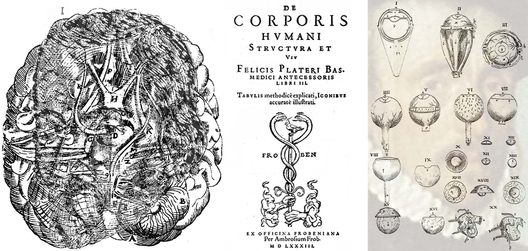Felix Platter1536–1614
Platter is shown in the base of his brain as illustrated in his book on anatomy, the title page of which is shown in the centre. In his diagram of the eye, Platter moved the lens towards the pupil and recorded the differences between the curvatures of its front and back surfaces. He also suggested that the retina rather than the lens was the sensitive organ of vision: “The principal organ of vision, namely the optic nerve, expands through the whole hemisphere of the retina as soon as it enters the eye. This receives and discriminates the form and colour of external objects which together with the light enter the eye through the opening of the pupil and are projected on it by the lens.” Platter’s diagrams of the eye were reprinted in Kepler’s Optics which gave the full description of image formation on the retina. Platter described the movements of floaters in the eye and he gave an account and interpretation of vertigo: “An intense, uniform, and extended movement of the head transfers itself in a similar way to the spiritus. Despite holding the head still afterwards, it appears to continue moving for a while, before it eventually feels still. This is the basis for dizziness, if one rotates the head and body in a circle for a long time.” Platter received his medical training in Montpellier and returned to his native Basel to practice medicine.
